Super Zangyura is a game by PlatineDispositif (http://www.platinedispositif.net/) and is a remake of a title originally released in 2004. He has been updating several of his games over the past few years – Gundemoniums and Bunny Must Die! Chelsea and the 7 Devils – and this continues the trend. What’s a surprise is how quickly Super Zangyura was released in western digital marketplaces being a niche indie title, but I’m all for it.
The Baron has sent a brave Maid out on a quest to infiltrate the castle of the vampiric Immortal Lord and lay him to rest. Super Zangyura resembles the classic Castlevania format, particularly leaning into some of Vampire Killer’s elements, and provides several modes of increasingly difficult execution. The cute characters and atmosphere provide a backdrop to calculated movement and engaging bosses.
Maid-san’s main form of attack is a flail. She can whip it forward or she can charge it up by spinning it above her head. If you attack while spinning the flail the attack will have some extra range and power, and also penetrate through walls and enemies – useful for checking for breakable surfaces. If you jump while spinning the flail your descent will be slowed, and if you want to cancel the spinning without attacking (this is relevant more than you would first think) you can simply crouch. While crouching, Maid-san can do a short dash forward.
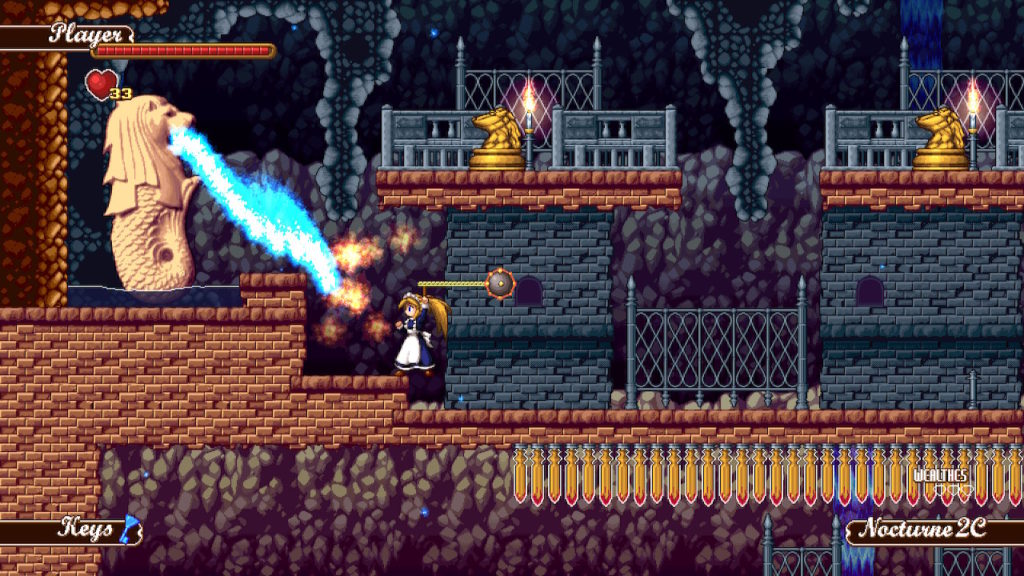
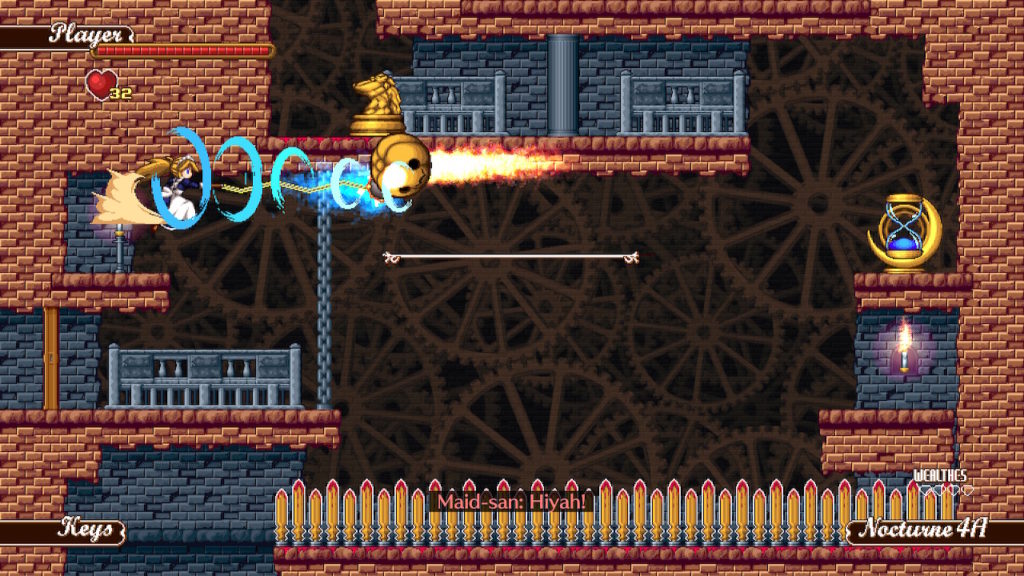
Super Zangyura can be a demanding game depending on the mode you select, however there is a shop that you can use to buy Indulgences before jumping back into the game. These Indulgences include extra attack power, or extra lives, or even spare keys and you can even decide to disable them after buying if you want to try to run through the game without them.
Like the classic series Castlevania titles, there are several Areas broken into Sub-Areas that ultimately culminate in a boss fight. Maid-san must navigate enemies and traps and puzzles and bottomless pits until she reaches each sub-area door leading deeper into the level. Where it resembles Vampire Killer is in the level design and execution.
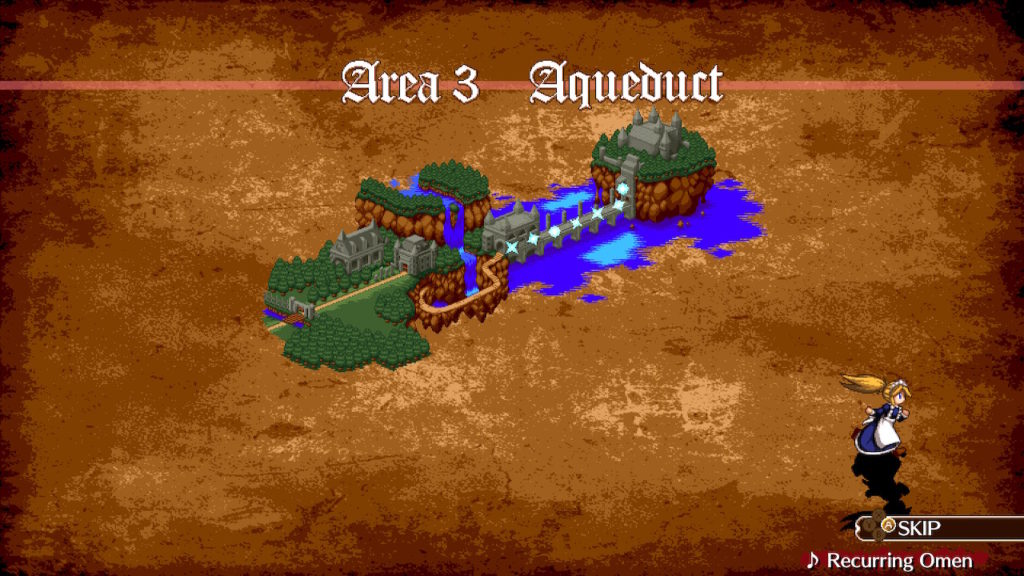
Vampire Killer tasks you with finding keys to end of area doors. Super Zangyura as well leans heavily into coloured key and door puzzles that gate progress for Maid-san. Levels in Super Zangyura are not just played left to right, many of them can scroll up and down as well so exploration is important and the order in which you use keys becomes essential as well. On harder difficulties, proper key order is required unless you bought some of the spare keys mentioned earlier. But there are no puzzles in the game that outside indulgence is required for.
It is important to note that while Super Zangyura resembles games like Vampire Killer it is its own entity with its own mechanic and flavour. Thus it stays interesting.
While it is possible to get stuck by using a key on the wrong door, especially on difficulties past Etude, you can always restart the current sublevel entirely at the cost of one life. It becomes essential as you play deeper and deeper into this game to recognize red herrings. You need to check walls and surfaces near locked doors because sometimes you don’t have to use that key at all. The game gets more and more arcane the deeper you go, but it has this obtuse logic about it that you begin to get a handle on.
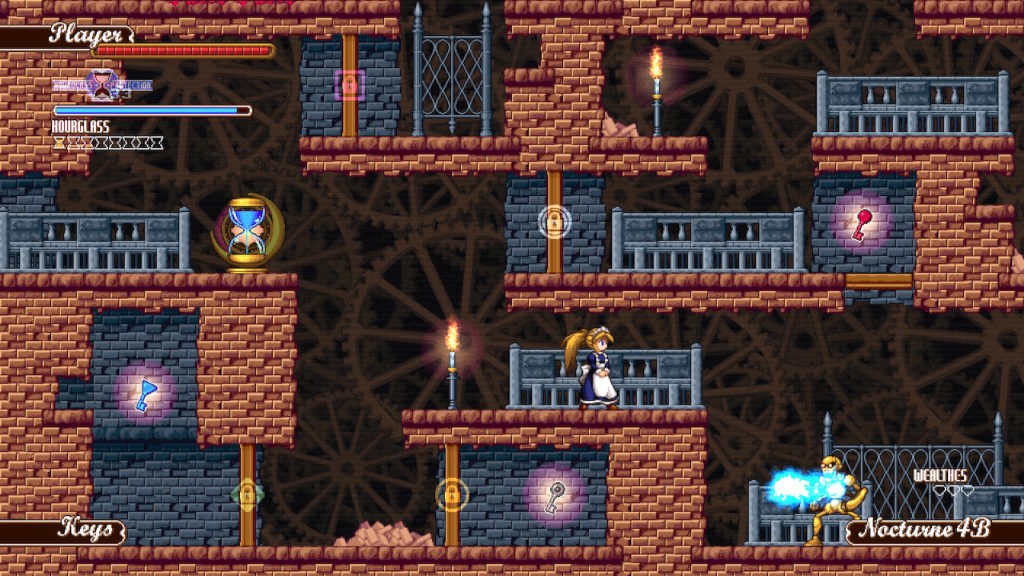
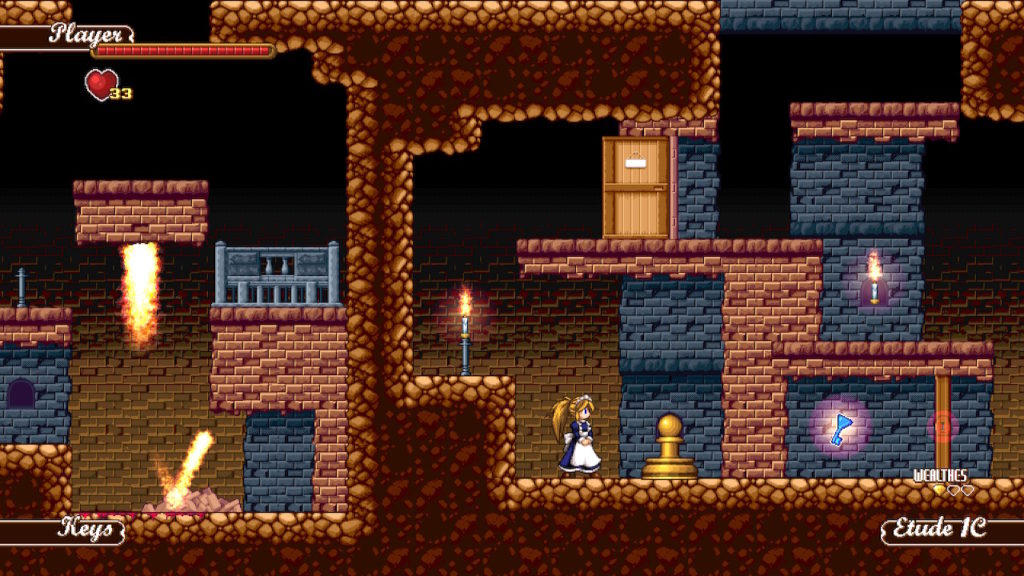
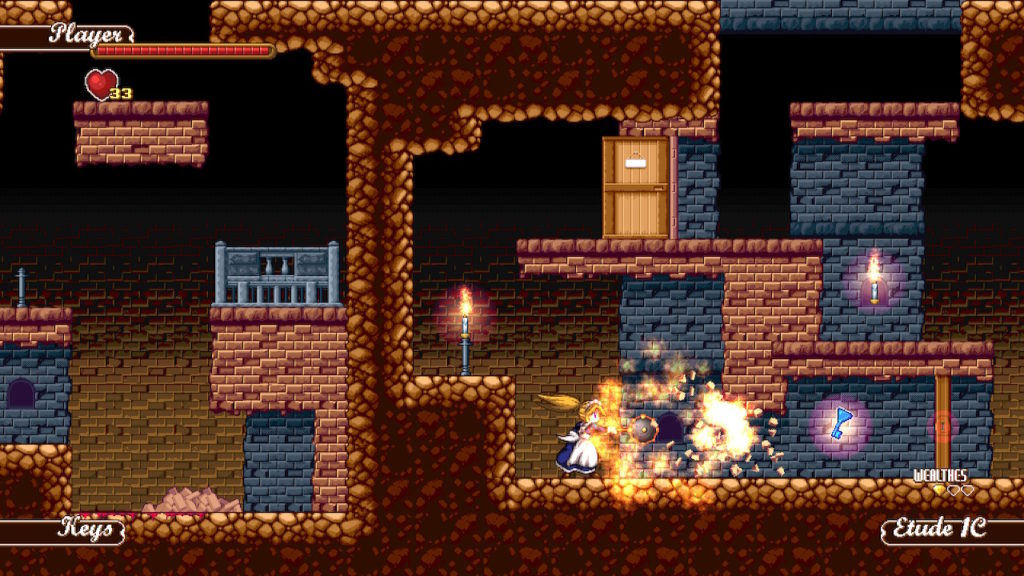
At the end of every main level Maid-san will need to fight a boss. When you’re playing on most difficulties, these bosses will be far easier than navigating levels. They’re fun and inventive but by spinning the morning star flail above her head Maid-san can protect herself from many of the attacks and if you upgrade your weapon in the shop they drop very quickly. The exception to this rule is the final bos of a loop being much more involved (but again, you can keep upgrading) and the bosses on the most difficult mode of all which are all remixed and fought without upgrades
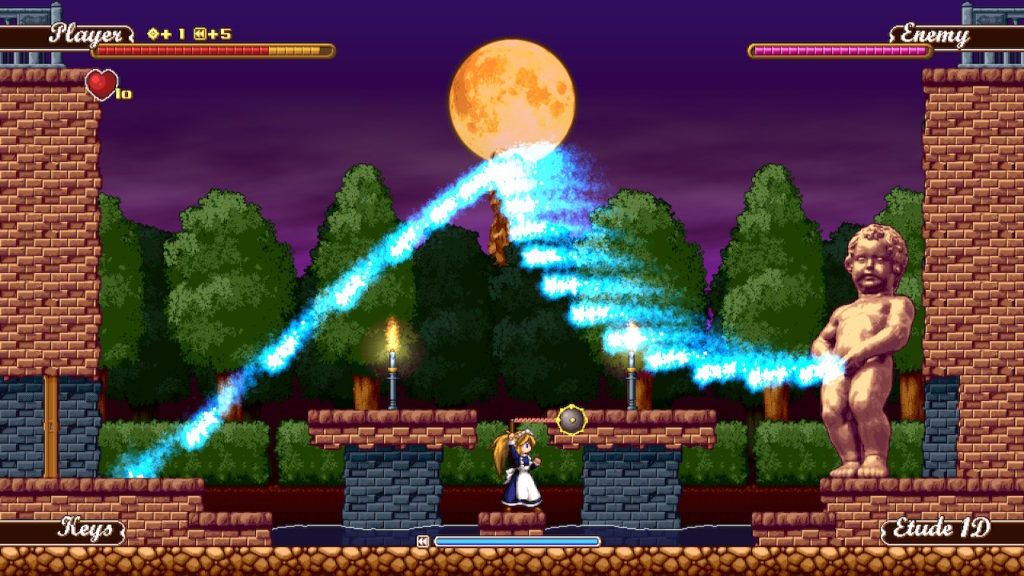
While Super Zangyura can be a difficult game, I’ve already mentioned the Chronus Shop. As you hit certain criteria more upgrades will become available. But upgrading your life meter, amount of lives, and attack power have an immediate and powerful effect on your survivability in a level. What has the greatest impact, however, is the Rabbit’s Pocket Watch. The Watch allows Maid-san to rewind time to a point. The timer has limitations – the duration is limited (though you can buy more duration per use) and you need to activate it immediately upon dieing or Maid-san will fully die and you can’t use it to save her. There are a few other peculiarities to keep in mind – such as the duration is drained immediately upon collecting items and must then recharge – and that this ability is unavailable to you until you purchase it for the first time.
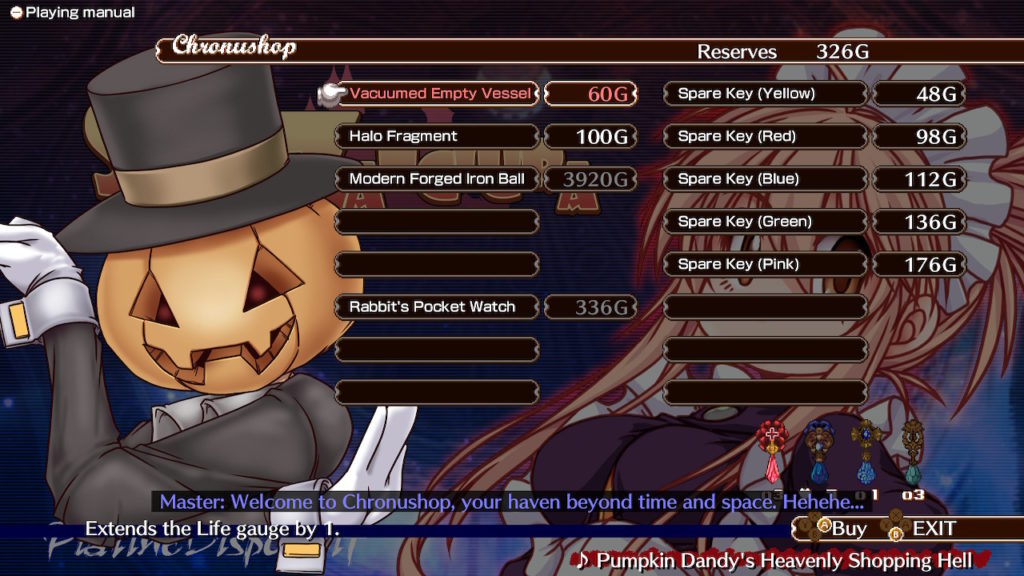
Super Zangyura is a short game. It’s just the right length that the limited pool of enemy types doesn’t feel too limited and the gameplay is tight enough that escalating versions of the traps and obstacles across the difficulty modes never feels stale. As far as these modes are concerned, there are four levels of difficulty or level sets in Super Zangyura. At the start of the game you will only have access to Etude, billed as Super Easy, and Nocturne which the game bills as Super Hard. This in itself is a trick. Seeing as there’s no Normal mode, if you’re used to 2D action games you’re probably going to want to start with Nocturne.
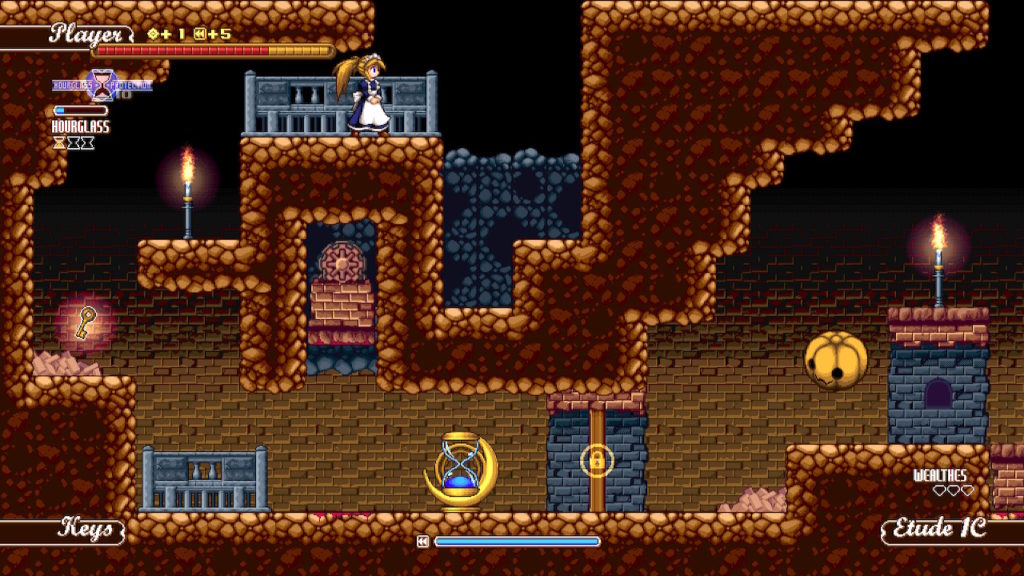
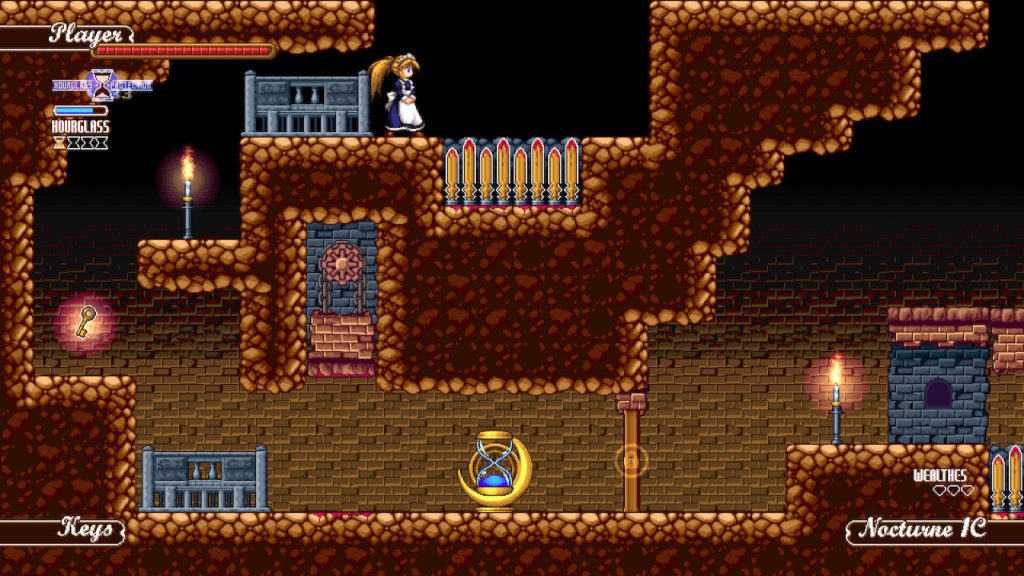
Nocturne doesn’t take long to start throwing in false floors, or doors that need to be skipped, or spikes at screen transitions where you wouldn’t expect them. Etude is indeed much easier, but it does teach you many of these tricks in a more organic way. But Nocturne’s not too tough yet and it’ll teach you some of the treacherous logic the game abides by sooner.
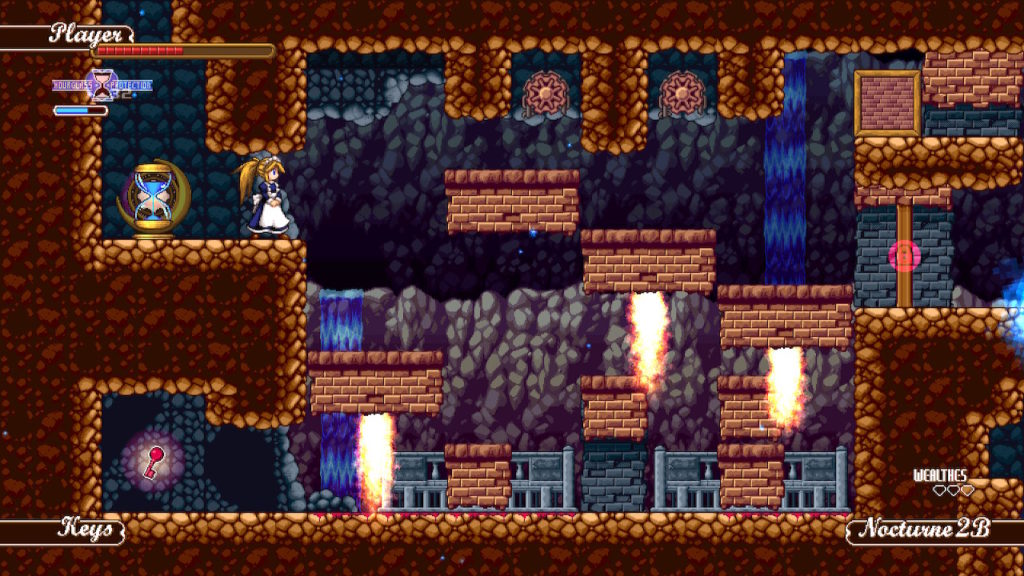
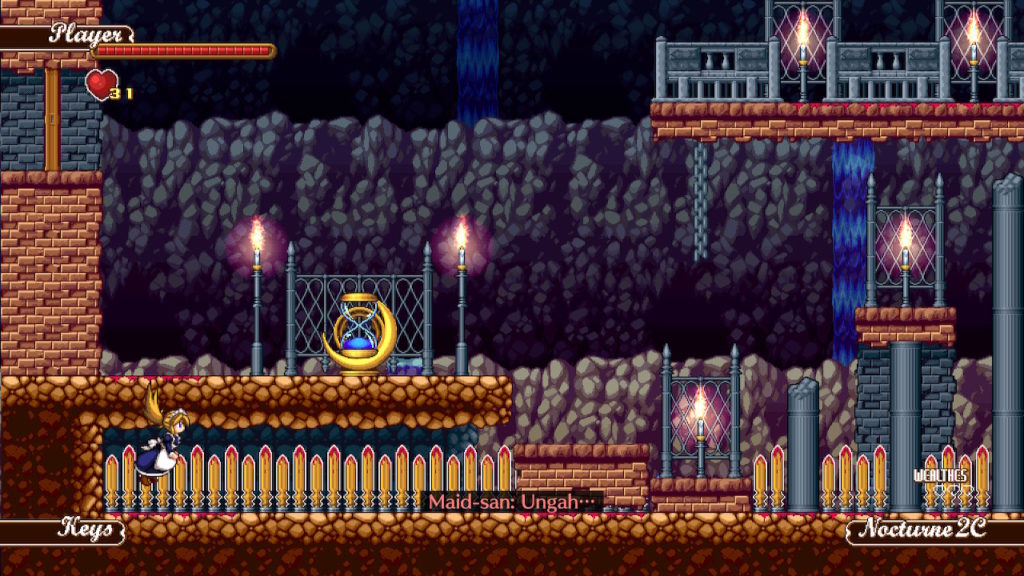
There are two more modes in this game, and if you don’t want to read about them then skip the next paragraph entirely.
At some point in the game you will have the option to unlock the way into Overture Mode. Overture has no subareas, instead it truncates many of the features of the regular areas into one larger area that really leans into the key mazes seen earlier in the game. There are some new surprises in here, and while it’s generally a little harder than Nocturne I think everyone who enjoys this game should at least do Overture. The other difficulty that you can unlock is Knightmare and this is the most difficult level set the game has to offer. There are many tricks and obscure solutions throughout, and there’s an even greater demand on your dexterity. There are no achievements associated with clearing Knightmare, but if you’re already a fan of Platine Dispositif games you’re probably going to make a run at it. Please note that the only indulgences you can take with you into Knightmare Mode are the extra lives. But since you’re going into this mode with the expectation that it’s going to be punishing and for the express purpose of just clearing it then I think that if you’re an enthusiast you’re going to persevere. While Knightmare seems overwhelming at first, there’s solutions for everything and once you execute some of the more demanding movements a few times they start to become natural. It looks unfair, but in most cases it isn’t (except the smashing blocks you can barely slide under, ha ha).
Super Zangyura updates its visuals without getting away from the feeling of the original Zangyura. It looks pretty solid and the animations are very nice. Most importantly in a game like this, there’s a lot of visual clarity. It’s easy to see enemies against the background, it’s easy to quickly gauge positions, and there are many visual hints scattered throughout the game. A floating candle post might denote a hidden platform in the air and a bloodstain under a spike-lined ceiling might tell you that one particular section of that ceiling might drop to perforate our intrepid Maid (although this is not a hard rule on later difficulties). Bosses absolutely shower the screen with their attacks and I haven’t noticed any performance drops on the Switch.
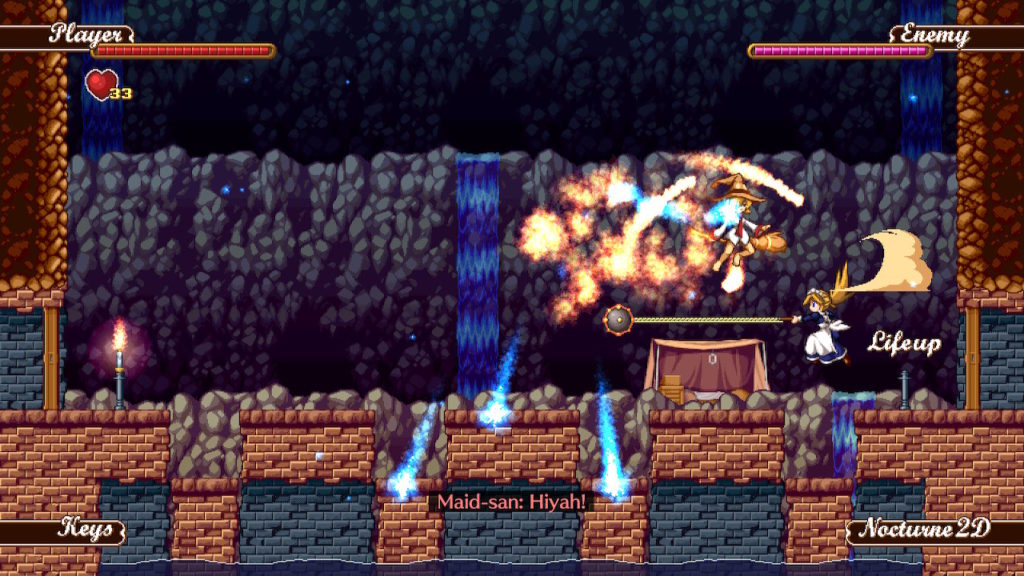
Super Zangyura also has a really great soundtrack, really evoking the theme of vampire slaying 2D action games.
It’s still bewildering that the turnover for a Super Zangyura translation was so swift. This game has a niche audience and there’s no denying it. The classic Castlevania format isn’t an untapped genre (the recent Bloodstained prequels for instance) but the Symphony of the Night or Metroidvania style is much more readily associated with the series in general audiences especially since Metroid angle becomes more and more prevalent especially in indie games. Hollow Knight is one of the biggest examples there. In that sense, it’s still refreshing to have a game, remake or not, really embrace the format. Super Zangyura does offer some concessions, but they’re all optional.
It’s games like Super Zangyura that make me wish I was aware of the original almost 20 years ago now. The only title by PD that was on my radar at the time it was current was Bunny Must Die! and due to my own lack of savvy and the language barrier I didn’t play that until years and years later when it was remade. But as these games get remade I really do hope they find their audiences and they get played by the folks who would love them.
Having not played the original I can’t comment about how faithful this game may be to it, or how the difficulty stacks up. But I think Super Zangyura is in a good place in terms of providing a solid experience to fans of the genre.
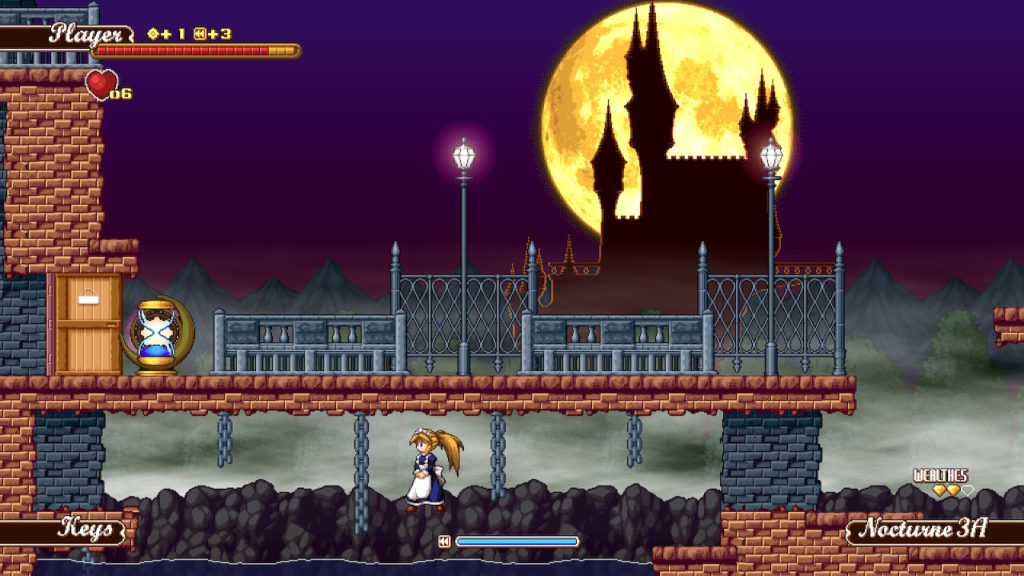
Where does Super Zangyura fall in terms of recommendation? I think if you’re an enthusiast of the genre it’s worth having a look. I will say, if you intend to only play through Etude, it might be difficult to recommend on grounds that your available content will be very limited. If you want to play through Super Zangyura I’d recommend playing through at least Etude, Nocturne, and the unlockable Overture. But I think if you have a predisposed interest in this game you’re probably going to want to go further still.
I always find it difficult to flat out recommend games on my blog because I often cover titles that have a niche appeal. Super Zangyura still falls into that category, but if you grew up with games like this or are just an enthusiast Super Zangyura offers a lot of humour and clever execution and some challenging trials. It’s a game that deserves a look if it already checks some of those boxes for you. Super Zangyura’s Western release is on the Nintendo Switch and PlayStation 4.
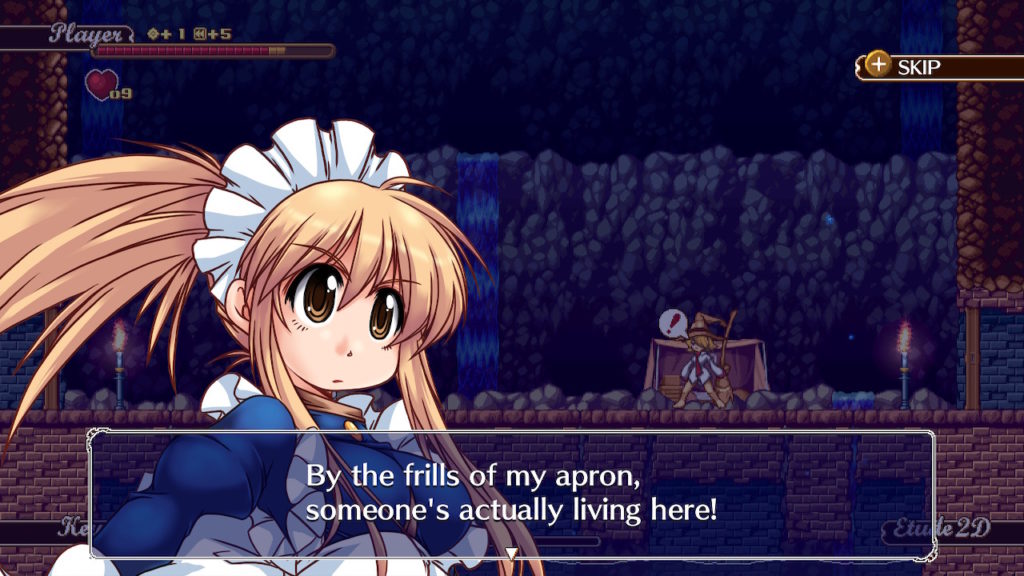
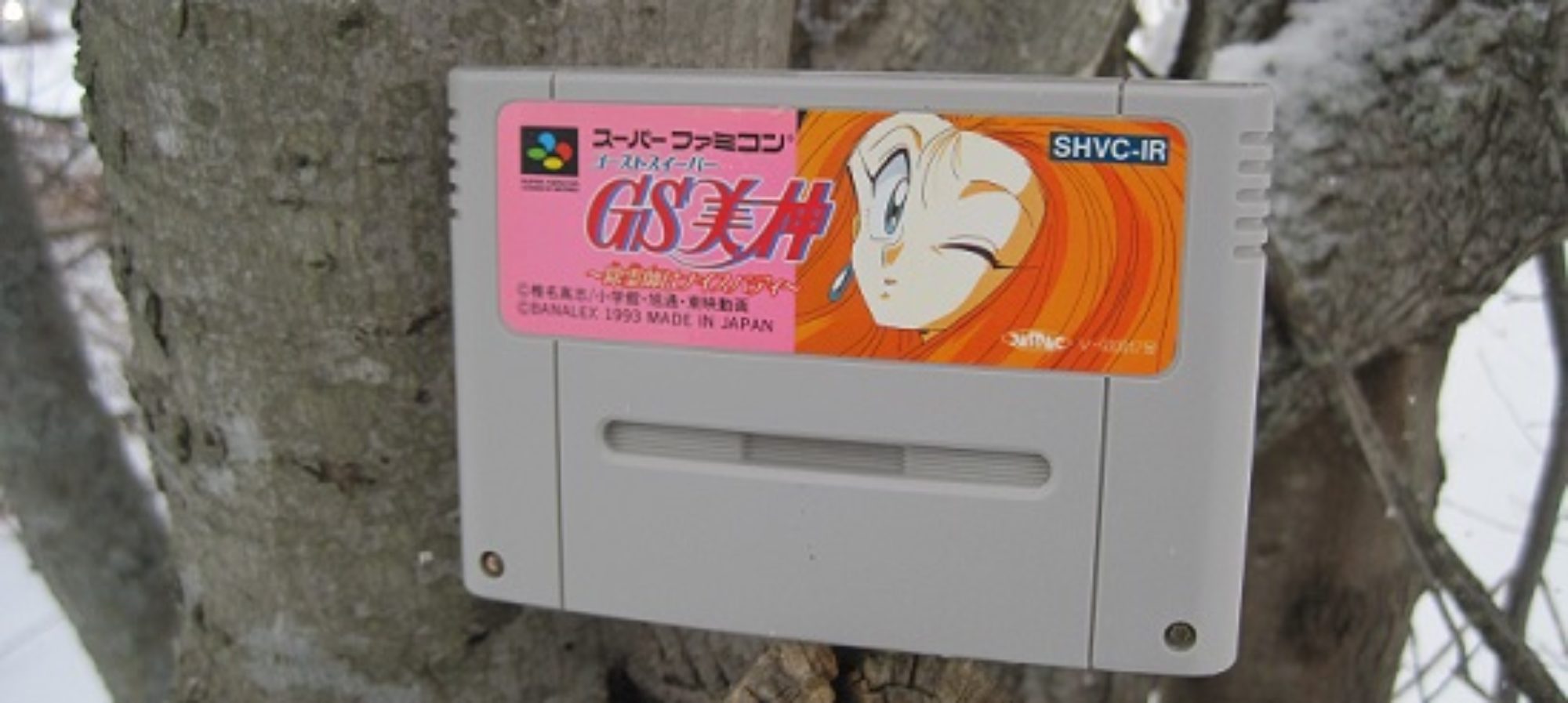
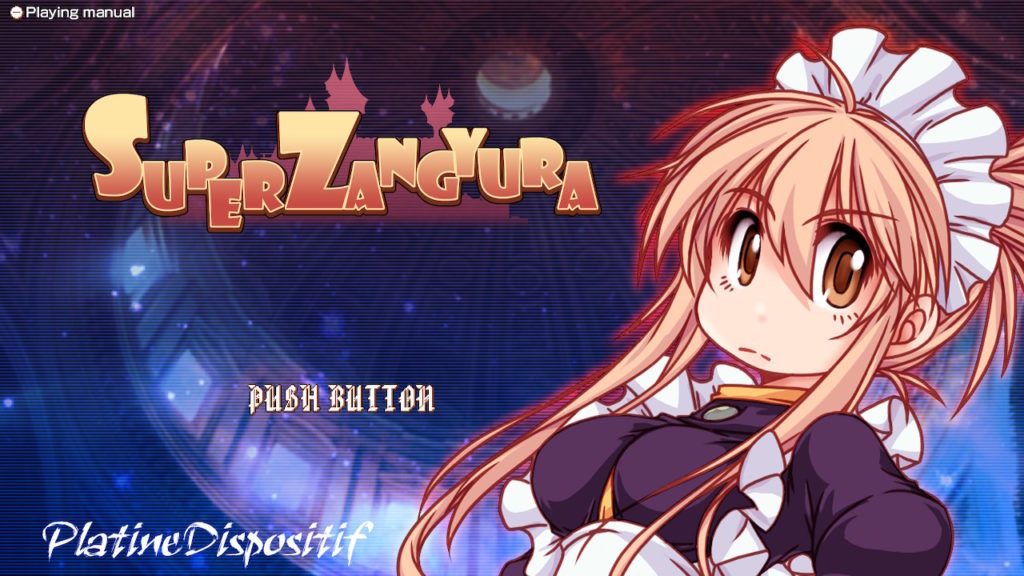
I saw that you posted this and then forgot about it for a bit, ha ha.
I would say it looks fairly good, but there are quite a lot of Metroidvania games now and others that look more interesting to me, but hey, I don’t play games anymore? lol Glad you liked, anyway!
Why isn’t the pissing statue boss’ piss yellow though?
Yeah I guess Piss-Poor Boy should have yellow but I don’t think they load the actual Manneken Pis with urine lol. I think the reason there is that there are several other enemies that use streams of blue so it’s a matter of shared resources.
Would have made it funnier, though, lol. Whether it’s a sentient statue or loaded.